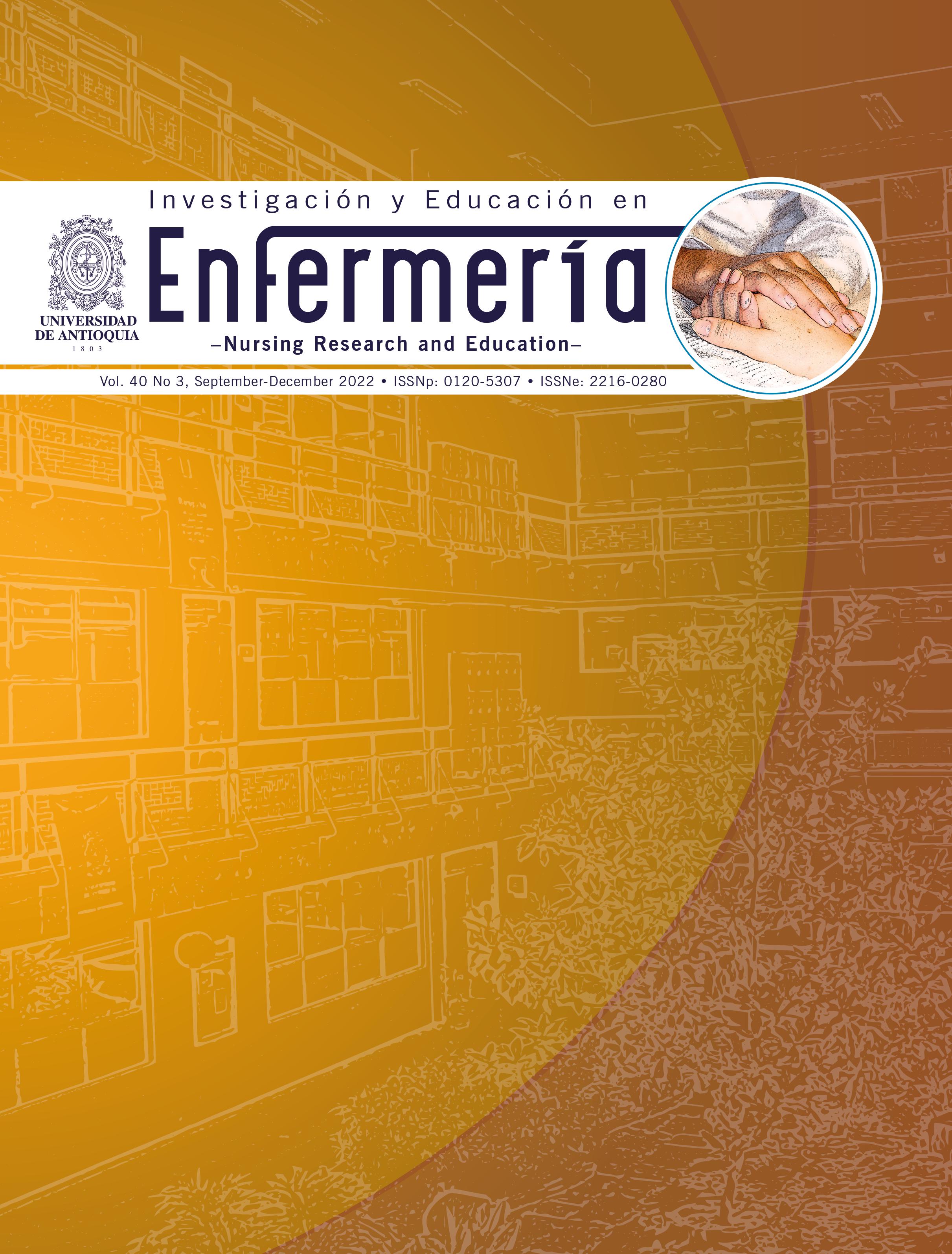Adaptation by Men to the Nurse Role. "Being Craftsmen in the Construction of their Professional Trajectory"
DOI:
https://doi.org/10.17533/udea.iee.v40n3e12.Keywords:
masculinity, men, gender identity, education, nursing, nurses, male, professional practiceAbstract
Objective. This work sought to describe the adaptation process by men to the nurse role.
Methods. Secondary analysis of data from a collective case study that had as participants 12 male nurses working in the city of Medellín, with ages between 28 and 47 years and average time of professional experience of 11 years. Information collection was carried out through in-depth interviews. The analysis was conducted through Roy’s Adaptation Model (RAM), reading of the interviews, identification of RAM’s components, grouping of fragments, assignment of tags, construction of a matrix and classification.
Results. The analysis performed accounts for the coping processes and adaptation by male nurses and the ineffective responses (control of emotions and emotional silencing) when practicing a role considered feminine.
Conclusion. In this study, it was possible to establish that, to achieve adaptation within nursing, men use strategies related with changes in bodily appearance, management of physical strength, and management of emotions.
Downloads
References
1. Barquet J, Vázquez J. Aproximación a la teoría de la performatividad desde Judith Butler. ScientiAmericana. 2021; 8(2):51-60.
2. Scarafoni ME. División sexual del trabajo doméstico y el uso del tiempo en las tareas de cuidado. DerSocial.2016; (14):127-36.
3. Fernández-Feito A, Basurto-Hoyuelo S, Palmeiro-Longo M, García-Díaz, V. Differences in professional values between nurses and nursing Students: a gender perspective. Int. Nurs. Rev. 2019; 66(4):577-89.
4. Ashkenazi L, Livishz-Riven I, Rommen P, Grinstein-Cohen O. Male Nurses in Israel: Barriers, Motivation, and How They Are Perceived by Nursing Students. J. Prof. Nurs. 2017; 33(2): 162-9.
5. Tian X, Deng Y. “Organizational Hierarchy, Deprived Masculinity, and Confrontational Practices: Men Doing Women’s Jobs in a Global Factory”. J. Contemp. Ethnography. 2017; 46(4):464-89
6. Honneth A. Reconocimiento y menosprecio sobre la fundamentación de una teoría social. Buenos Aires: Katz Editores; 2010. p. 23-35.
7. Roy C. Elements of the Roy Adaptation Model. In: Roy C. The Roy Adaptation Model. New Jersey. Third Edition: Upper Saddle River (NJ): Pearson Education; 2009. p. 25-54.
8. Ruggiano N, Perry T. Conducting secondary analysis of qualitative data: Should we, can we, and how? Qual. Soc. Work. 2017;18(1):81-97.
9. Curtis S, Gesler W, Smith G, Washburn S. Approaches to sampling and case selection in qualitative research: examples in the geography of health. Soc. Sci. Med. 2000; 50(7-8):1001-14.
10.Stake R. Analysis and Synthesis. How Things Work. In: Qualitative Research Studying How Things Work. First Edition. New York: The Guilford Press; 2010. p. 133-56.
11. Viorato N, Reyes V, Bernal M. La Ética en la Investigación Cualitativa. CuidArte. 2019; 8(16):35.43
12. Ministerio de Salud. Resolución 008430 [Internet]. Bogotá 1993. [Internet]. [Consulted 15 Sept. 2021]. Available in: https://bit.ly/3tvMurF.
13. Roy C. Synthesis of Middle Range Theory of Adapting to Life Events. In: Generating Middle Range Theory from Evidence to Practice. New York: Springer Publishing Company; 2014. p. 233-52.
14. Gugel S, Duarte C, Lima A. Valorização da enfermagem brasileira: analisando aspectos históricos e de gênero. Nursing. 2020; 23(264):3930-3.
15. Burguette MD, Martí G, López J, Martínez JR. Acceso a los estudios de Enfermería en función del sexo de los estudiantes. Rev ROL Enferm. 2018; 41(7-8):534-42.
16. Ayala R. Biopoder: el poder y la violencia en la formación de profesionales de enfermería. Educ. Med. 2008; 11(3):125-9.
17. Peña J, Inda C, Rodríguez Menéndez M. La teoría cognitivo social de desarrollo de la carrera: evidencias al modelo con una muestra de estudiantes universitarios de la rama científica. Bordón. 2015; 67(3):103-22.
18. Labra O, Bergheul S, Turcotte P, Dubé N. Men Studying in Professions Conceptualized as Female in Quebec. GKA revSOCIAL 2017; 6(1):1-10.
19. Cottingham M. Caring Moments and Their Men: Masculine Emotion Practice in Nursing. NORMA. 2017; 12(3- 4):270-85.
20. Bacete R. ¿Por qué están tan enfadados algunos hombres? In: Nuevos hombres buenos La masculinidad en la era del feminismo. España: Ediciones Península; 2017. p. 75-81.
21. Velandia Ana. Influencia de la “Cuestión Femenina en la educación de enfermería en Colombia. Invest. Educ. Enferm. 2013 ;20(1):36-52.
22. Ahmed S. Sentir el propio camino. In: La política cultural de las emociones. México: Universidad Nacional Autónoma de México; 2015. p.19-47.
Downloads
Published
Versions
- 2023-09-20 (3)
- 2023-08-23 (2)
- 2022-11-12 (1)
How to Cite
Issue
Section
License
Copyright (c) 2022 Investigación y Educación en Enfermería

This work is licensed under a Creative Commons Attribution-NonCommercial-ShareAlike 4.0 International License.
Derechos de propiedad / Direitos de Propriedade
English: If the article is accepted for publication, all copyright will be of exclusive property of Investigación y Educación en Enfermería. The text and the graphics included in the publication are exclusive responsibility of the authors and not necessarily reflect the thought of the Editorial Committee.
Español: Si el artículo es aprobado para publicación, todos los derechos son de propiedad de Investigación y Educación en Enfermería. El texto y las gráficas incluidas en la publicación son de exclusiva responsabilidad de los autores y no necesariamente refleja el pensamiento del Comité Editorial.
Português: Se o artigo for aceito para publicação, todos os direitos autorais serão de propriedade exclusiva de Investigación y Educación en Enfermería. O texto e os gráficos incluídos na publicação são de responsabilidade exclusiva dos autores e não refletem necessariamente o pensamento do Comitê Editorial.















